Each type of nursing shift has its advantages, which is why healthcare facilities use a combination of different types of shifts for nurses’ shift-work schedules in order to meet patient care needs, satisfy nurses’ working requirements, and promote a healthy work-life balance for nurses.
Although research suggests that the healthiest shifts are those that begin from 8:00 a.m. onwards, many healthcare facilities care for patients 24 hours a day. That is why healthcare CEOs must find the right balance for running a facility with a 24/7 schedule while considering the needs of the workforce to ensure the continuous smooth-running of the facility.
The benefits of creating a well-balanced, healthy shift schedule
A well-balanced shift work schedule allows nurses working full-time to have:
- A healthy work-life balance
- Good physical and mental health
- Employee well-being
- Job satisfaction
- Effective time management
- Seamlessly coordinated shifts that run one after the other with no slack or overlap
Here are some benefits for the facility from creating healthy nurse schedules:
- Increased employee retention
- Ease in recruiting top nursing staff
- Full staff availability and attendance
- Optimum nurse engagement and productivity
- Efficient facility operations
- Avoid overtime costs
Creating well-balanced and healthy shift schedules for your nurses will ultimately improve your facility’s customer service and patient outcomes, open the door to collecting top reviews and guarantee maximum facility efficiency.
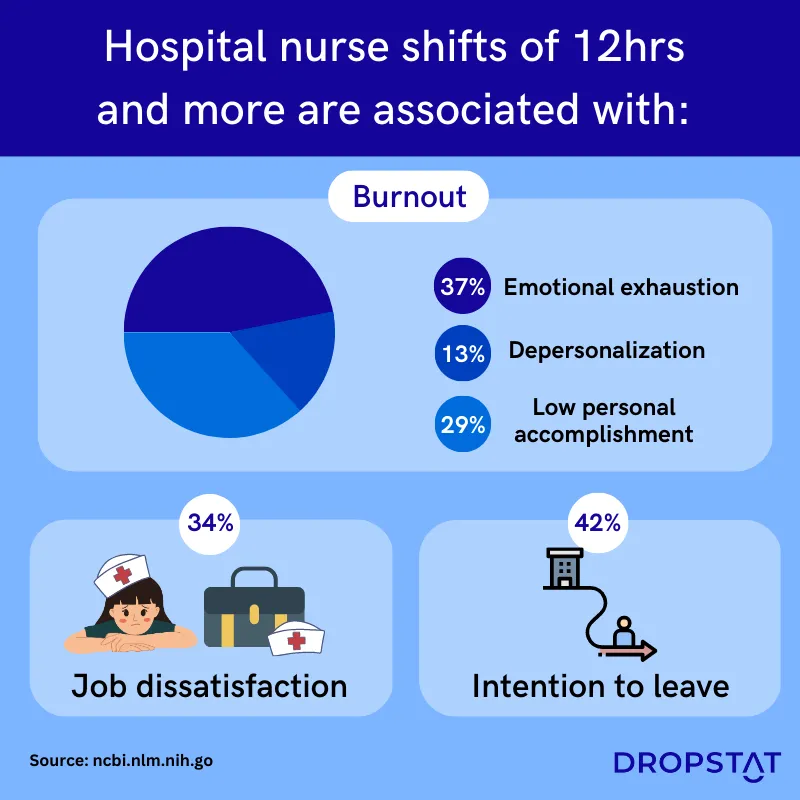
8 fundamental components of a shift work schedule for nurses
Schedulers manipulate many factors for building nurses’ work schedules. Each factor contributes to making the nurse schedule a healthy one. Some of the main points are:
- Length of shift
The length of the shift will determine how many shifts there are in each 24-hour day of work. Having three shifts means diving 24 hours into 3 eight-hour shifts. Having three shifts with a staff overlap means having 3 ten-hour shifts. Having 2 shifts would mean scheduling 2 twelve-hour shifts. The maximum shift length is mandated by the state in many states.
- Format of shift schedule
When a healthcare facility runs round the clock, the workers work in shifts, covering all 24 hours. The main types of schedule formats are fixed shifts and rotating shifts. Fixed shifts are when workers keep to the same work hours each day they work. Rotating shifts are when workers have a rotating pattern of days when they work or are off duty. The pattern spreads over a number of weeks and then repeats.
- Downtime
Healthcare workers work demanding cycle days and hours. They must use the chunks of time off to rest and enjoy socializing and recreation. Vacations and holidays must be fairly incorporated into the work schedule.
- Policies and regulations for schedules
Healthcare policies in a facility are internal rules and conventions that govern how the facility manages its workforce. Examples of internal regulations are: how close to the start of a shift a scheduler can cancel, overtime pay policy, shift differential policies, holiday and vacation pay, and method of choosing overtime staff. Examples of external regulations that govern schedules are limits on how long a person may work within a day or week, minimum legal wage, meeting the safe staffing levels required by the state, paying for all hours worked, and minimum age requirements.
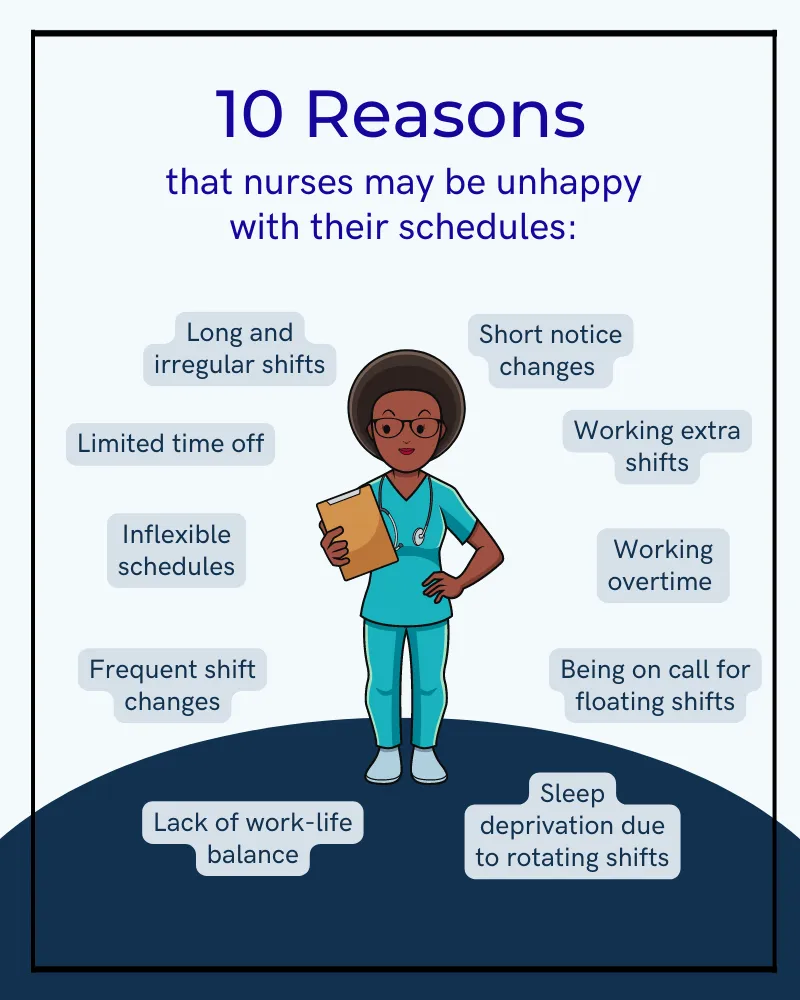
- Overtime pay structure
When the facility needs more hours from workers than they normally work (such as during holidays or during emergencies) and workers are able to work those extra hours without harm, working overtime is a good solution. Workers are either paid at a special overtime rate (considered voluntary overtime) or are expected to work more hours as part of their full-time schedule (referred to as mandatory overtime).
If the overtime mechanism is abused, it can backfire on the staffing schedule if employees respond with increased absenteeism and work less efficiently, maybe even leaving their place of work. For the financial health of the facility, the coordinator must ensure that premium overtime pay is minimized by keeping track of who is permitted to work overtime and whether there is a cheaper alternative, such as hiring more permanent staff members. In some states, nurse overtime is capped.
- Staff sufficiency
Not having adequate staff available and working was the most commonly reported source of nurse stress. Having enough staff is essential for creating a workable staff schedule. Mandatory overtime is common for RNs or nurses whose skills are in short supply. One forward-thinking solution would be to encourage current staff towards career advancement and qualifying as RNs.
- Facility and employee wellbeing
Coordinators must ensure that employee shift schedules work to the benefit of the healthcare facility – with no gap shifts. They must also ensure that the employee shift schedule matches employee preferences for them to maintain a healthy work-life balance.
- Communication
Good communication is an essential component for building a shift schedule. Quality, effective communication negates misunderstandings between staff members, and staff squabbles. Clear, effective communication in nursing using the right tools enables:
- Instant communication between nurse schedulers and nurses of open shifts
- Collaboration for making schedule changes
- Nurses can communicate their availability for setting their shifts in advance
- Visibility of shift updates to relevant parties
Interestingly, study results indicate that increased internal communication, or collaboration across nursing teams, improves coordination and seemingly reduces the need for overtime. This shows how communication is pivotal in full-shift coverage.
Different types of shift schedules for nurses
Although there are different patterns and forms for nurse shifts, research shows that typical work shifts are 7.6-8.6 hours. Nurses, who consistently work these long shifts, must be aware of employee-provided well-being options and take advantage of them to help them manage their workload without getting burnt out.
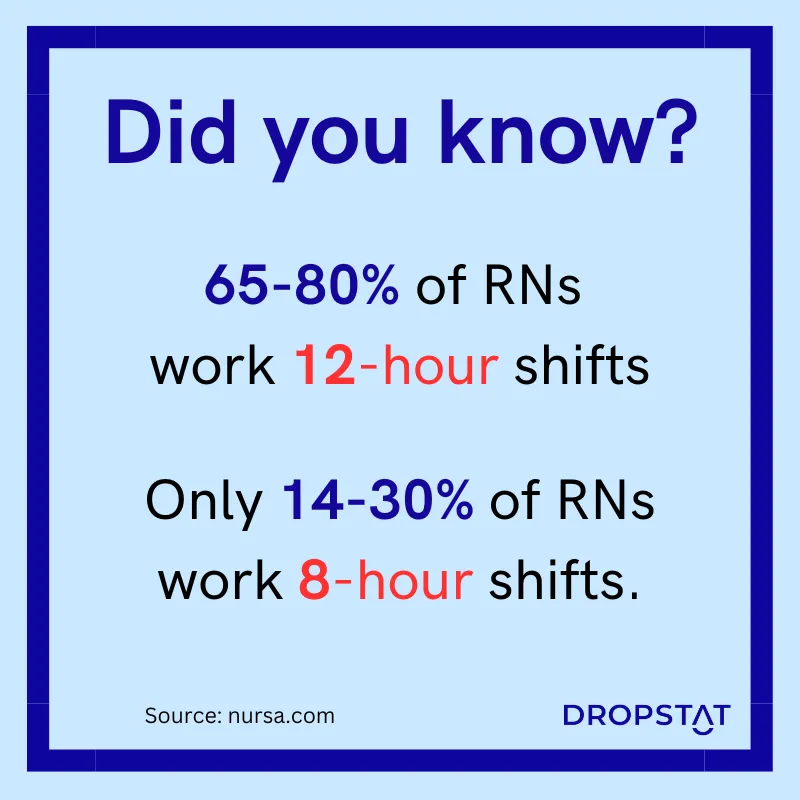
Shift lengths that most nurses work:
8-hour shifts: e.g., 9 a.m. – 5 p.m., Monday-Friday. This is a common shift for many nurses working in private practices. Usually, weekends are off. Nurses may swap shifts to be off at various other times during the week. Research on circadian physiology shows that 8 hours shifts are better than 12-hour shifts for natural body cycles.
10-hour shifts: 3 teams and the day is divided into 3 shifts. There are the morning shift, the night shift, and the afternoon or swing shift. There will be up to 4 workdays in the week. Nurses may schedule consecutive shifts or spread them out.
12-hour shifts: e.g., 7 a.m. – 7 p.m. This type of shift is the predominant registered nurse work schedule. Twelve-hour shifts are great for productivity since there are fewer shift changes, reducing pick-up time.
Being on call or Pro Re Nata (PRN) – Nurses work when needed. They don’t have a fixed schedule. Shift PRN nurses work for multi-location healthcare facilities and fill in wherever there are staffing shortages.
Self-scheduling by nurses working their schedule around their lives: This is found in some healthcare facilities. Nurses choose the shifts that they are qualified for while complying with facility guidelines. Nurses may swap shifts in this flexible scheduling option. Research reveals that only 68.1% of nurses have schedule satisfaction. Shift swaps allow nurses to create doable work options instead of taking leave. Studies show that nurse satisfaction increases when nurses are involved in the scheduling process. As much as possible, nurses should be supported in choosing the shift type that works best for them.
Types of shift patterns that many nurses work:
Different types of rotating shifts and one type of fixed shift for 12-hour shifts, all giving 24/7 coverage, are:
The Pitman schedule – Fixed – 4 teams, a cycle of 2 weeks. Each team will work the same shift (day or night)throughout the cycle.
The Pitman schedule – Rotating – 4 teams, a cycle of 2 weeks. Teams alternate the day and night shifts. The Pitman schedule is a type of rotation shift schedule most commonly used in scheduling for medical service providers.
The DuPont schedule – 4 teams working an average of 42 hours a week.
The Panama schedule – 4 teams working 56 days in a cycle (28 days for days schedules and 28 days for night schedules). Around 42 hours in a week. It is a ‘slow-rotating’ shift system.
The DDNNOO schedule – 3 teams work an average of 56 hours a week (incorporates 16 hours of overtime). It is a ‘fast-rotating system.’ Also called 4-on, 4-off (i.e., the nurse work schedule is: 4 nights on – 4 nights off, and 4 days on 4 days off.) This type of shift may be day only, night only, or day-then-night in a multiple-week cycle.
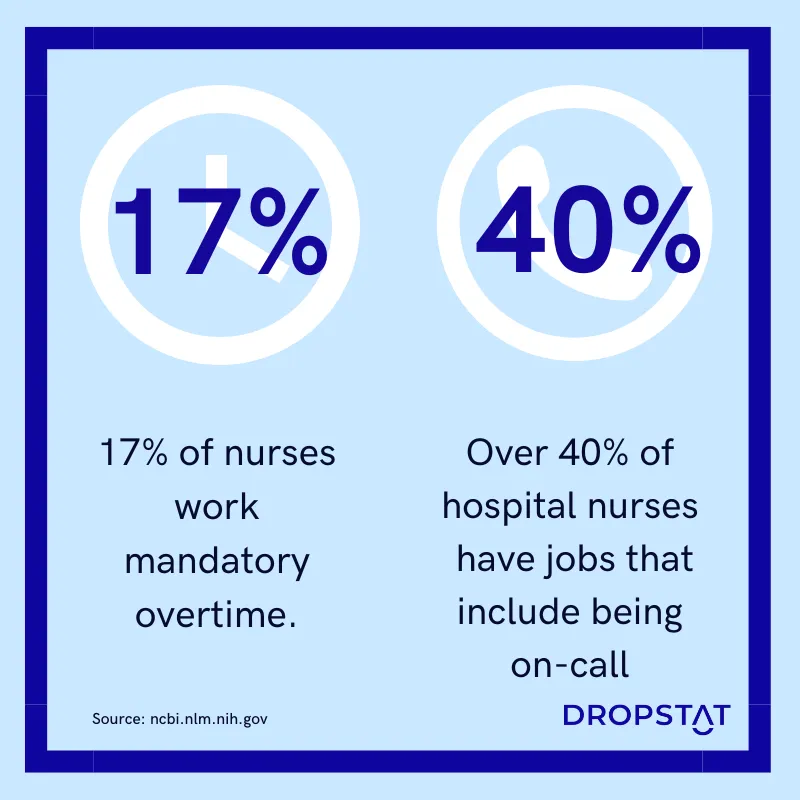
While working a longer-than-normal workday, nurses must not disregard health risks that come from fatigue and accumulated stress. Patient safety and well-being are just as important and are bound closely to nurses’ well-being. Nurses typically work 35 to 48 hours weekly (hours beyond 40 hours a month are automatically at the overtime pay rate). More hours are usually expected in busy, general hospitals.
A typical nurse schedule includes the night shift
Many nurses prefer working day shifts, especially over-45-year-olds or nurses who have health conditions and need a good night’s sleep. However, many typical nurse schedules include a portion of night shift work. Some nurses actually prefer the night shift, especially if there is a fair pay advantage over the day shift. The advantage of the night shift is there are usually fewer procedures to carry out and fewer distractions from monitoring patients and admin tasks.
What are the healthiest ways to schedule night shifts for your nurses?
- Grouping night shifts one after the other, 2 or 3 at a time, allows nurses to get used to the shift pattern.
- Encourage nurses to take a nap before beginning their shift and allow windows of time for power naps during night shifts if needed.
- Consult with lighting specialists about providing artificial daylight lighting for better moods in nurses (10,000 lux of light) during and after the night shift.
- The night shift (the “third shift”) begins at midnight or 11:00 p.m. to 7:00 a.m. or from 7:00 p.m. through 7:00 a.m. Encourage employees to sleep the full 7-9 hours needed, from 9:00 a.m. – 5:00 p.m. or in two ‘doses’ from 9:00 a.m. to 2:00 p.m. and from 6:00 p.m. to 9:00 p.m.
- Schedulers can take the responsibility of conducting mini-surveys asking nurses how they feel about their work on the night shift. By checking in on nurses’ mental health, they can use the opportunity to suggest tips for maintaining a healthy routine and suggesting tips for healthy routines.
How to promote a healthy lifestyle for nurses with heavy work-shift schedules
If your full-time nurses work between 35 to 48 hours a week, excluding additional overtime, here are some ways to promote a healthy lifestyle for your nurses:
- The longer a nurse works, the more important it is for a nurse to get some sunshine, eat healthily and exercise sufficiently. Offering healthy options in the cafeteria and supporting vacation requests could help nurses stay healthy. In schedules for the patterns listed above, workers work 3 or 4 shift days at a time and then have days off. These are long shifts, and healthcare managers must plan for employee well-being accordingly.
- Offer staff well-being checks, such as end-of-shift feedback, one-on-one quality time meetings with nurse leaders, and therapy to relieve stress.
- Help your nurses maintain a healthy social life by providing vouchers for family and friends entertainment venues, publicizing healthy screen time recommendations to nurses, and promoting a healthy sleep routine that allows for social life.
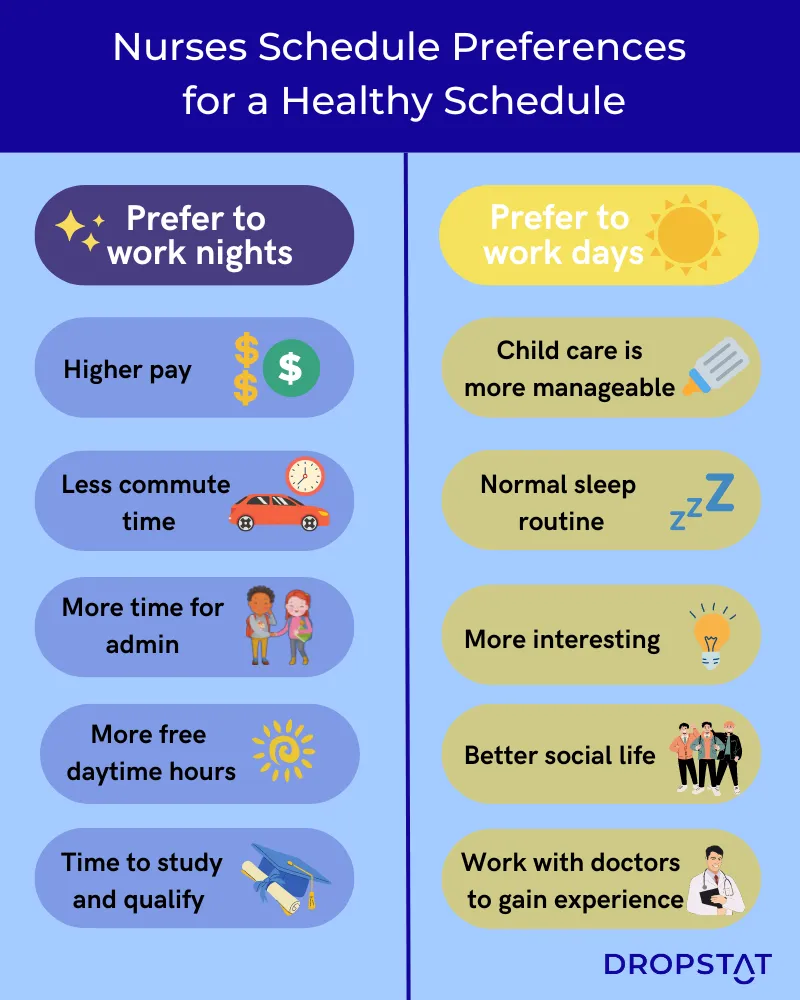
What are the most recommended nurse schedules?
There is no one perfect schedule. Probably, offering nurses a variety of schedules that are suitable for the care department in question is the best option. Allowing nurses as much space as possible to choose their schedules breeds nurse satisfaction. Using nurse scheduling software with a shift schedule calculator provides a helping hand to coordinators.
A study about preferred work patterns for new LRNs found that 13% of participants hold a second job. This shows that they may be less available for being on-call. However, they did voluntarily provide around 3 hours of overtime weekly. This begs the question, how many hours do nurses think they can work without damaging their work-life balance and reservoirs of strength?
Communication between schedulers and nurses is essential to ensure that the chosen schedule works and, if not, to make appropriate adjustments.
How Dropstat helps healthcare facility CEOs create the healthiest shift work schedules
When a facility builds its nurse schedules, it must consider what is best for the patients, nurses, and the facility as a whole. However, by automating the scheduling process, the challenging task of manual nurse schedule coordination is minimized.
Dropstat’s master schedule enables schedulers and healthcare managers to see at a glance the shifts that are filled and the shifts that require more staff, the levels of discipline that are required, and the cost for each shift. This helps schedulers make cost-effective staffing decisions when filling shifts.
Dropstat is built to work in tandem with every state. After choosing the facility’s shift settings, Nurse schedulers enter applicable national and state-specific laws, such as permitted hours per shift, HPPD regulations for minimum staffing, and shifts per week. Nurses’ preferences are then inputted and integrated. This way, each nurse’s work-life balance is respected, and their needs are heard.
Dropstat supports whichever nurse schedule a facility chooses to adopt. Rotating shifts are supported up to a 7-week rotation pattern. The entire overall nurse schedule is viewable in an easy-to-use, clear, user-friendly layout. Every schedule in the app is printable for those who like to have a paper schedule at hand.
Schedule a Dropstat demo and start creating the nurse schedules that your staff has been waiting for.







